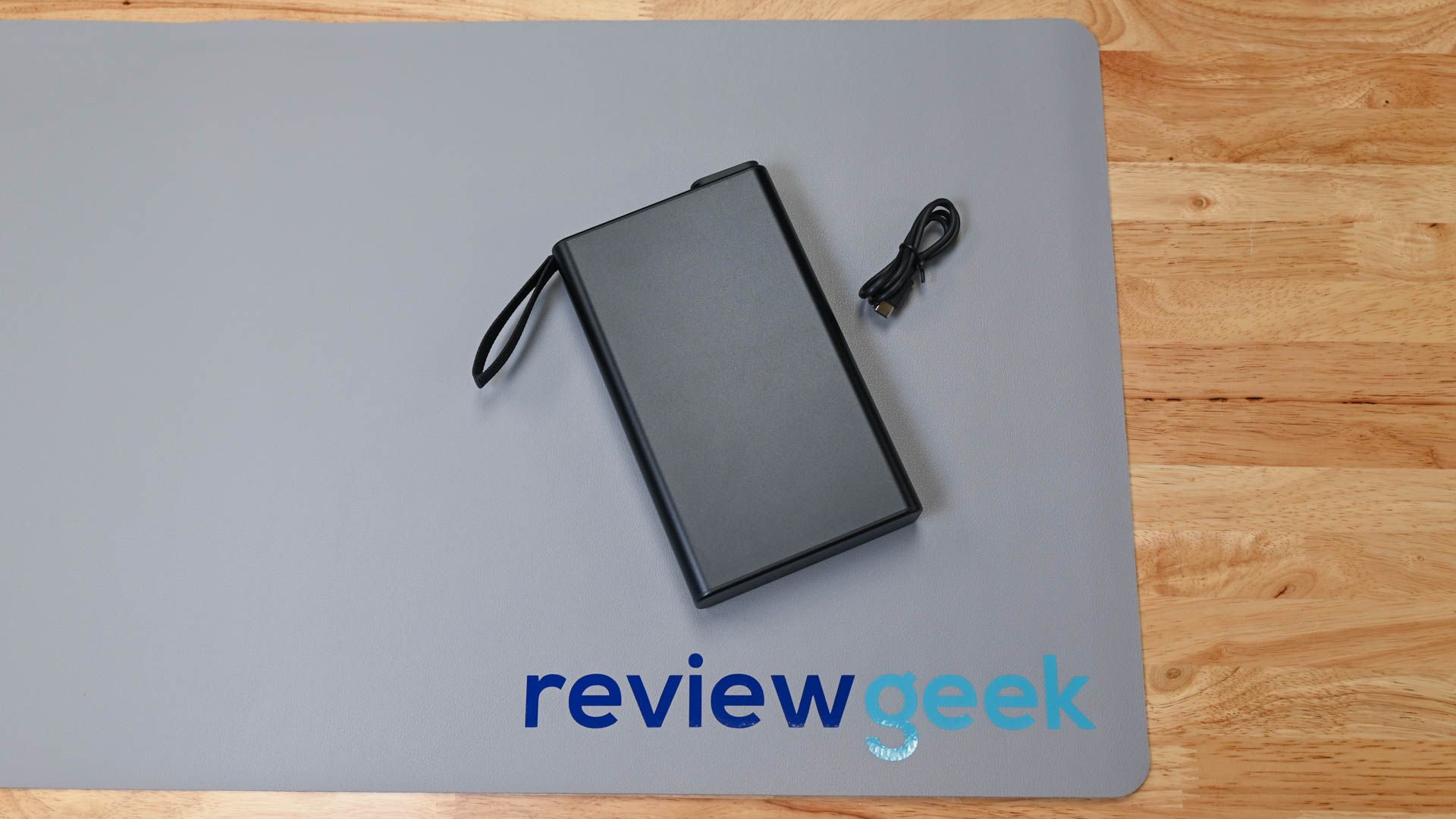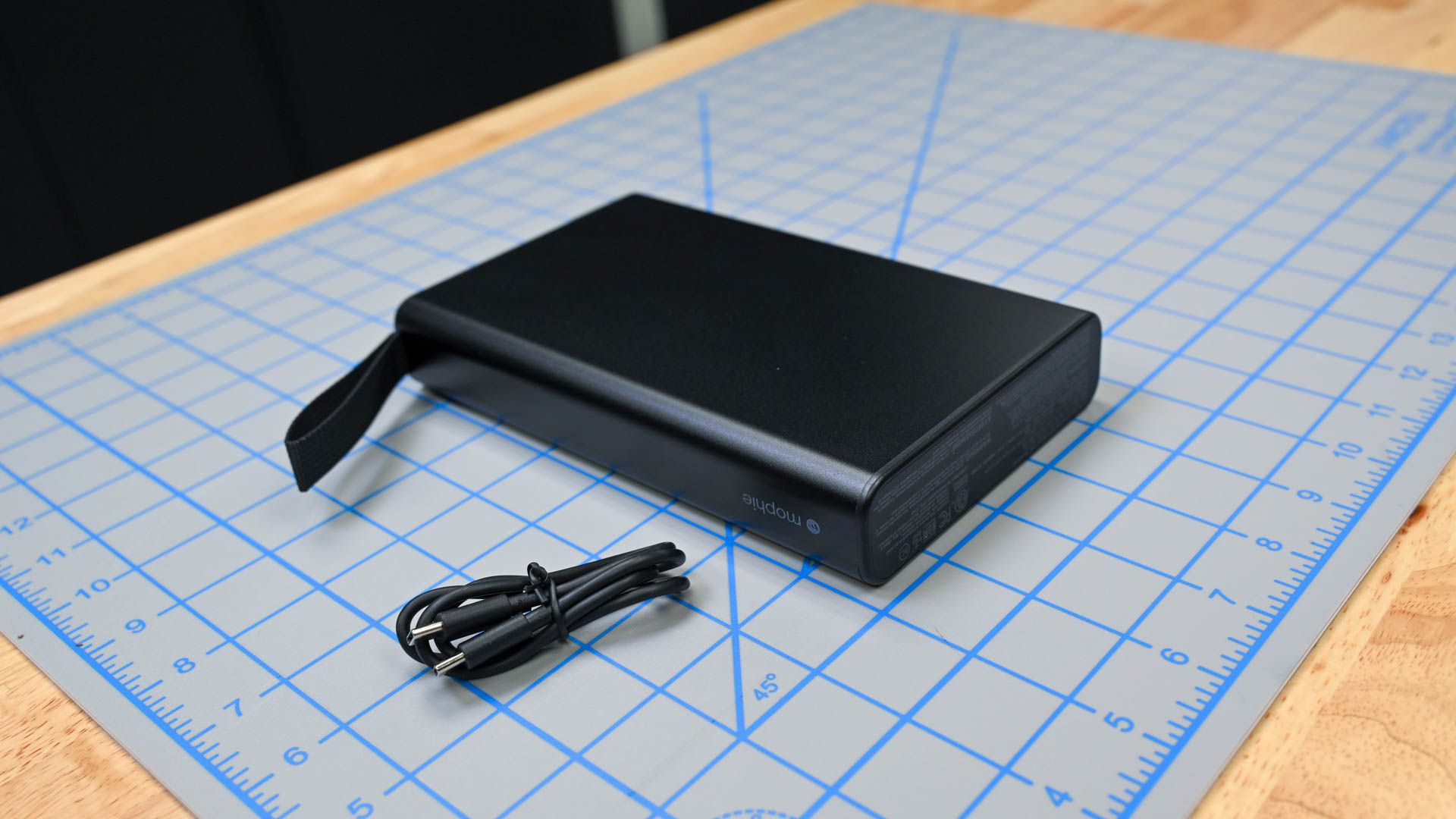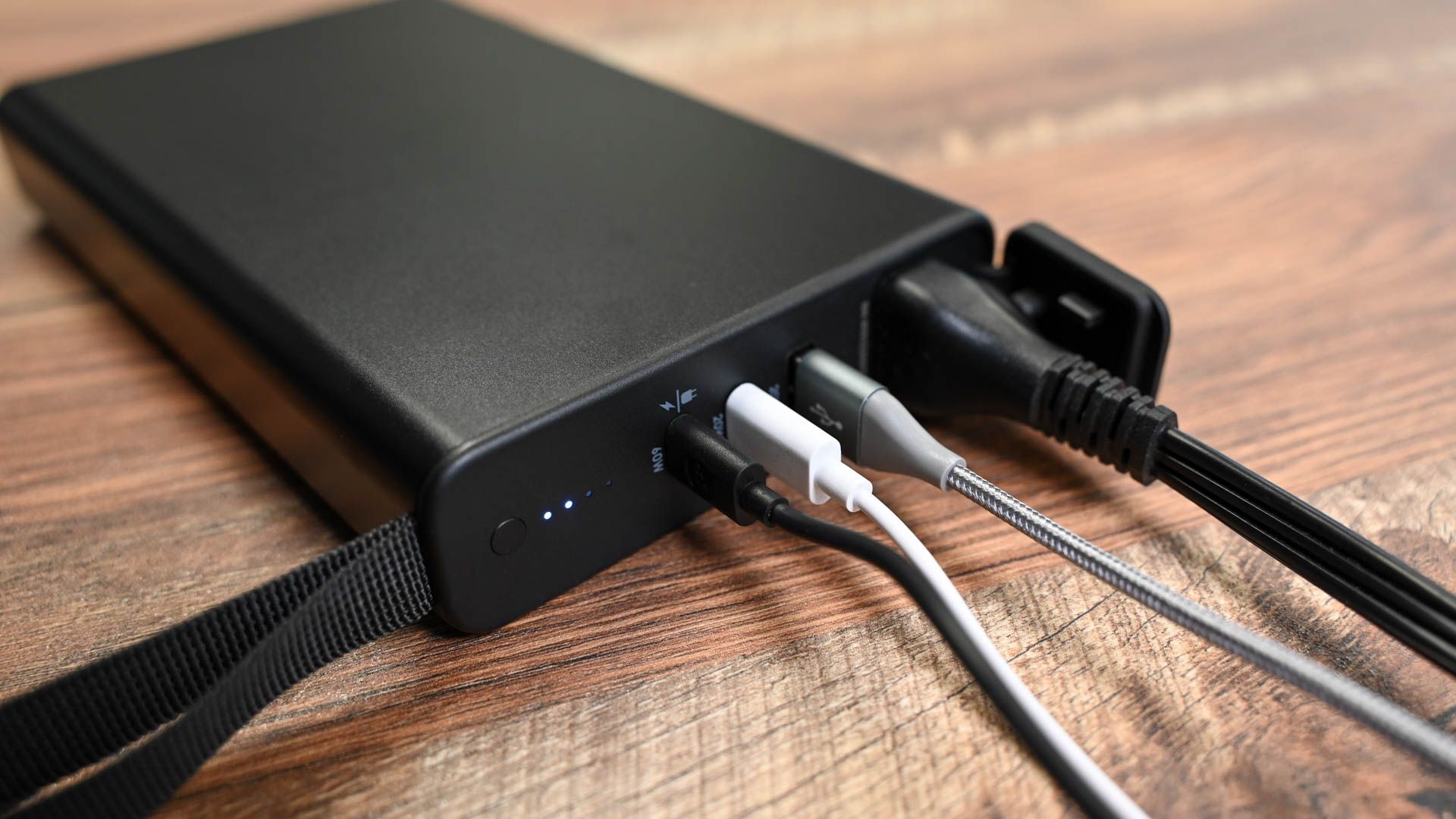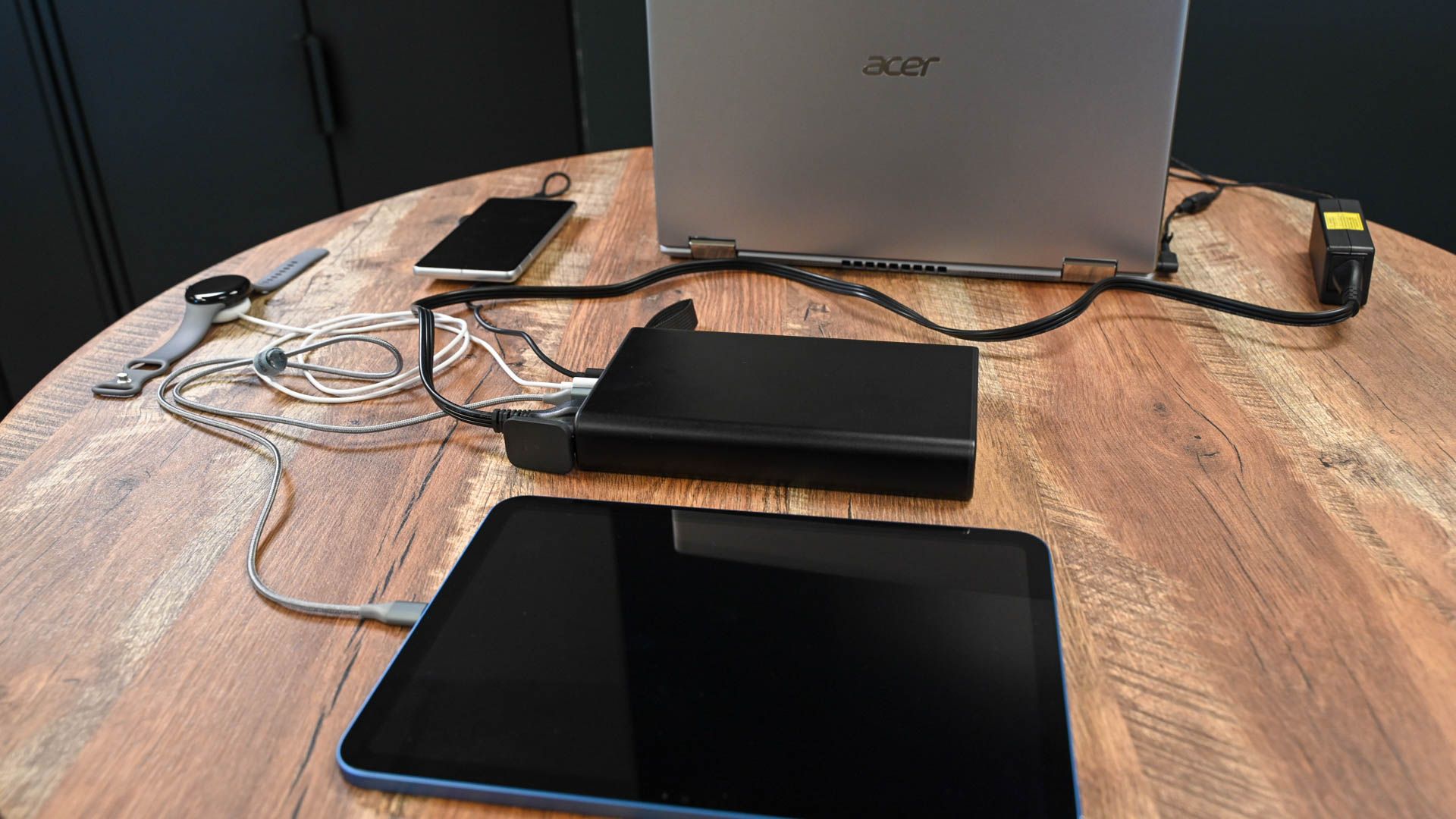Quick Links

The Mophie Powerstation Pro AC is the power bank you want for everything from day-to-day recharging to full-scale emergencies. It's portable, powerful enough to run small appliances, and built for quick plug-and-play operation. Yes, it's not cheap, but it's one of the best power banks on the market.
Design: Cue the Ride of the Valkyries
- Dimensions: 4.5 x 7.6 x 1.25in (114.3 x 193.04 x 31.75mm)
- Weight: 2.7lbs (1.22kg)
- Battery size: 27,000mAh
The Mophie Powerstation Pro AC is wrapped in a matte-black shell and measures 4.5 inches wide, 7.6 inches from top to bottom, 1.25 inches from front to back, and weighs somewhere in the area of 2.7 pounds.
You'll find all of the battery bank's USB ports and single AC outlet along the top of the device. There are two USB-C ports: one a 60W USB-C PD connection, and the other a regular 20W port. You'll also find a USB-A port that tops out at 20W, and when all four USB ports are in use, the powerstation is capable of outputting up to 130W.
Protected by a removable cap, the built-in AC outlet can deliver up to 100W, which is strong enough to recharge power-hungry peripherals like laptops and small-scale desktop setups (like a Mac Mini), and even some small appliances.
Next to all your inputs and outputs is a four-dot LED battery indicator and a power/status button. Press the button once to check the battery level of your powerstation. If you're new to Mophie products or battery banks altogether, the general rule of thumb is zero lights means the powerstation is bone dry, one light is zero to 25% capacity, two is 25% to 50%, three is 50% to 75%, and four is 75% to fully charged.
When you're charging the powerstation, use the supplied USB-C PD cable. Connect one end to the 60W PD port and the other to a USB-C power supply (I used the 60W one for my MacBook Pro).
With its 27,000mAh battery and integrated AC outlet, the powerstation could double as a brick. And not a power-adjacent one, mind you, but a literal brick. This monster of a charge station is heavy. Weighing around 2.7 pounds, I was always surprised when I picked up the unit because just to look at it, I would think about all the other large-scale power banks I've tested and think, "some of those were heavy too," but none have come close to the heft of this bad boy.
Frankly, I can't imagine lugging the Powerstation Pro AC into the wilderness. And if I did, I would definitely have it strapped to an already-full hiking backpack, so those 2.7 pounds would be buried. This isn't exactly a modern marvel, though; the battery bank looks and feels big because it's got some big shoes to wear. In fact, I think there'd be some red flags raised if an AC outlet-equipped power bank was as light as something like the Baseus 100W Laptop Power Bank.
Long story short: The powerstation is portable enough to tout around, but not exactly lightweight---at least as far as portable chargers are concerned.
Charging Experience: Lots of Battery to Give
- USB-C: Up to 60W (PD port), 20W
- USB-A: 20W
- All USB Ports: Up to 130W
- AC Outlet: Up to 100W
When first charging my iPhone 12, I connected it to the 60W USB-C port on the Mophie Powerstation Pro AC, with no other devices plugged in. At 2:23pm, my phone's battery was at 54%. I checked the charge status at 3:00pm and found that my phone had juiced up to 85%. At 3:19pm, it was up to 92%. And for this one hour of charging, my phone didn't draw much energy from the powerstation, which started out around 50% capacity and never decreased to the 25% or less indicator.
I also charged my 2021 MacBook Pro using the 60W USB-C PD connection when the powerstation had 25% or less battery remaining. I had a fair amount of work on my plate, so I needed to run Safari and my Notes app while my computer was charging. When I first plugged it into the powerstation at 4:16pm, my laptop's battery was at 64%. By 4:27pm it had gone up to 71%, and by 5:12pm it had increased to 82%. Had I not been actively using the MacBook during this hour, I'm betting it would have charged even faster.
Oh, and the reason I checked the powerstation battery level at 5:12pm was because I noticed my MacBook had stopped charging. Lo and behold, the powerstation had died. But considering it probably had less than 25% battery remaining when I first connected, and I had some "significant energy" apps running, an 18% boost in less than an hour is solid in my book.
When it came time to testing out the AC outlet, I was a little perplexed. No matter what I would plug in, the powerstation wouldn't power it. That's because I'm silly and didn't read the instructions that came with the Powerstation Pro AC. In order to turn on AC power, you need to press and hold the power/status button for about three seconds until the LED closest to the button lights up solid red. Now you'll be able to use both the AC outlet and the USB ports, and boy, did I put the powerstation to the test when it came time to try all the ports.
At 50 to 75% battery capacity, I did the following:
- Powered a 15W guitar amp
- Powered a three-way switching floor lamp with all three bulbs turned on
- Powered one bulb of this same lamp, in addition to powering one of those starry night projectors using the 20W USB-C port, while charging my AirPods Pro 2 using USB-A
I also attempted to power all three floor lamp bulbs with the above configuration, and everything worked for a minute. That is until I switched the projector to the 60W USB-C port, which cued the powerstation to scream at me.
I'm kidding, of course, but what it did do (which I was happy about) was kill power to the biggest energy-drainer: the floor lamp. I also liked that when the powerstation entered this failsafe mode, the red LED blinked red, indicating there was something wrong with either the power bank or one of the connections. I encountered this same blinking red light when trying to power a toaster with the powerstation, which never worked.
And best of all: During that heavy-duty testing session, the powerstation never dipped below 50 to 75% battery life (you can check battery status when in AC mode, too). That's impressive.
Price and Availability: Flagship Power Meets Flagship Pricing
As of this review's publication, the Mophie Powerstation Pro AC is only available through ZAGG's website and Verizon, but considering that pretty much Mophie's entire product catalog is available through Amazon and other noteworthy retailers, we're assuming the all-new Pro AC will get the same treatment soon.
Now as far as pricing goes, the Powerstation Pro AC retails for $199.99. Yes, that's not cheap by any means, but it makes me feel better to think of it like this: A full-fledged "let's go camping and power our campsite" power station from Jackery currently sells for $140. And while it's equipped with an AC outlet (150W max), DC ports, and USB-C (15W)/USB-A (12W) connections, the higher-priced Mophie Powerstation Pro AC is way more portable, and its USB ports are much more powerful, too.
Oh, and a full AC or DC recharge of the Jackery station takes up to five hours to complete. With its 60W USB-C PD, the Mophie battery bank can go from dead to full battery in a little less than three hours.
Then there's something smaller, like the Baseus 100W Laptop Power Bank that I recently tested. Selling for $130, this power bank is much lighter to carry, includes an LCD display with battery, voltage/amperage, and "time left" readouts, and rocks two fast-charging 100W USB-C ports (and two 30W USB-A connections). But guess what? There's no AC outlet, and I never once saw the USB-C ports hit anywhere close to 100W during testing.
Should You Buy the Mophie Powerstation Pro AC?
If you've got the spare change to drop on it, you should definitely consider picking up this battery. The Mophie Powerstation Pro AC offers some incredible charging capabilities, making it ideal for practical everyday use at the workplace, in a home office, or just hanging out on the kitchen island for the whole family to plug and play with.
Beyond the four walls of your home or traditional 9-to-5 lair, though, it's an awesome accessory to bring on vacations and outdoor excursions and is the power bank I would definitely want around in the event of an emergency, such as a power outage or the apocalypse. And I get it: $200 is a lot to ask for a thing that just charges your other things, but I bet we've all spent more on things that do way less things, am I right?
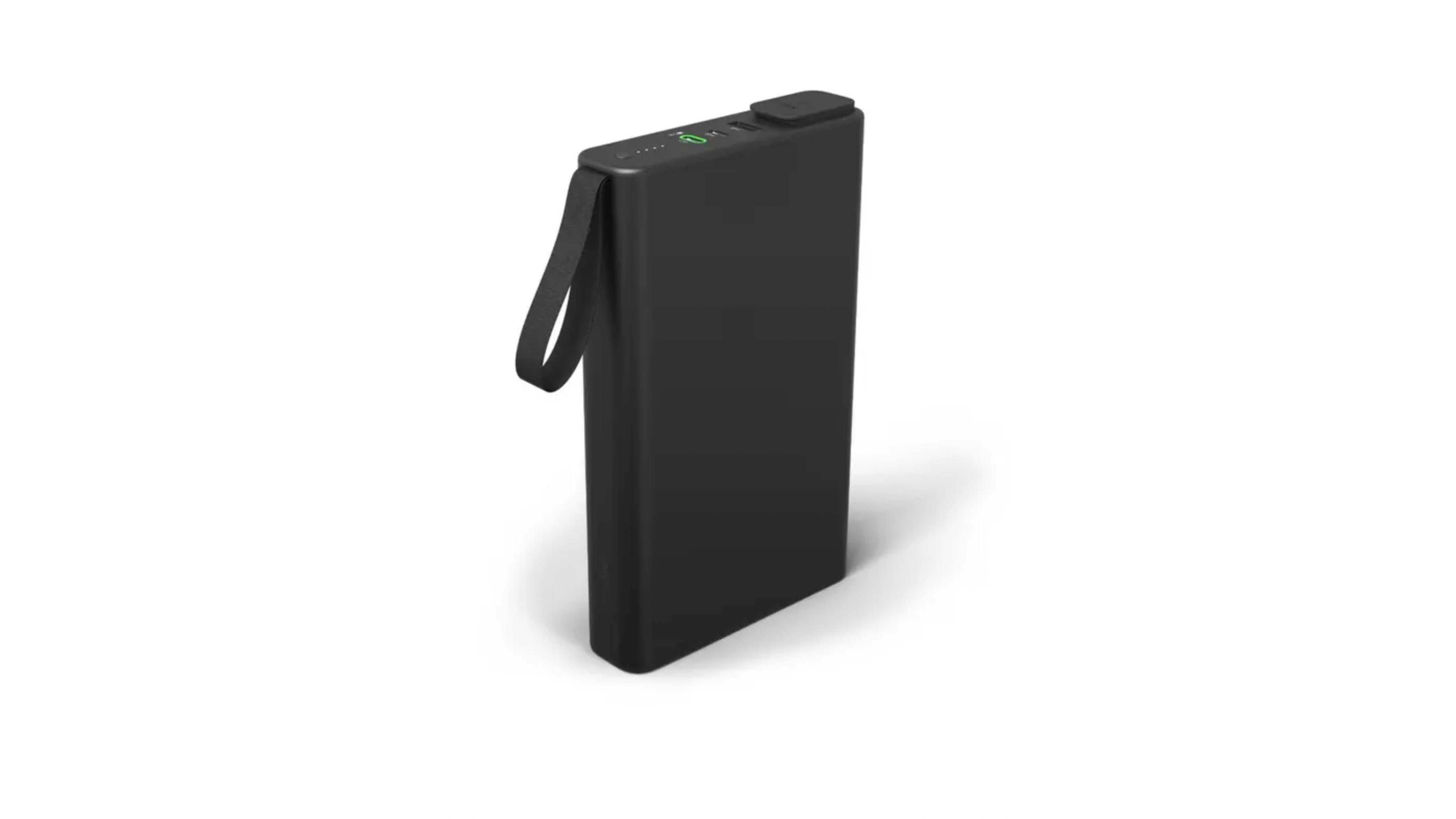
Mophie Powerstation Pro AC
- Incredibly powerful
- Offers USB-C, USB-A, and an AC outlet
- Amazing battery life
- Great alternative to a traditional power station
- Can run some small appliances
- Expensive
- Not exactly lightweight

